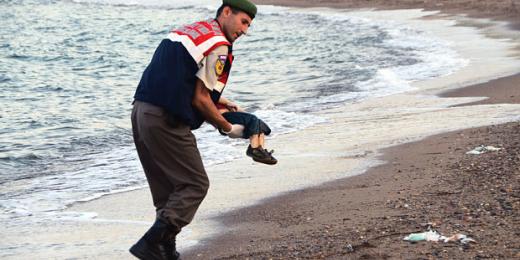UK and Europe-wide Responsibility Shifting of The Worst Refugee Crisis Since WWII

International Lawyer Dr Harry Hagopian and OTS Solicitors Human Rights and Immigration solicitor Mr Oshin Shahiean appeared on air to share their views on Europe's Refugee crisis and the UK's moral and legal dilemma on this topic following thousands of deaths at sea, and shocking photos of the tragic death of a Syrian boy.
“Give me your tired, your poor, your huddled masses yearning to breathe free.”
Europe's Struggle to Process Refugees
Globally, one in every 122 humans is now either a refugee, internally displaced or seeking Asylum. The rise of Islamic State (Isis) in Iraq and Syria and the horrific civil war that has been raging in the latter country for the past four years has resulted in the number of people displaced worldwide reaching its highest levels since records began.
Stark Facts Regarding the Migrant Crisis
- Every day last year on average 42,500 people became refugees, Asylum seekers, or internally displaced, a four-fold increase in just four years.
- In 2014 alone 13.9 million people became newly displaced – four times the number in 2013
- Half the world’s refugees are children
- Syria is the world's biggest producer of both internally displaced people (7.6 million) and refugees (3.88 million at the end of 2014). Afghanistan (2.59 million) and Somalia (1.1 million) are the next biggest refugee source countries.
- More than 2.8 million Iraqis have been displaced since the beginning of 2014
Unfortunately, rather than focus attention on the plight of the men, women and children fleeing persecution, torture, rape and murder in these countries, the media has chosen over the last few weeks on the problem European countries face in managing the influx of civilians fleeing violence and death in Syria, Afghanistan and Iraq.
Europe’s Struggle with Migrants
Some countries in Europe are finding it difficult to cope with the influx of migrants. They include:
Hungary
In 2014, Hungary received 42,000 Asylum seekers, up from 2,000 in 2012. The reason is that many Iraqi, Afghan and Syrian refugees walk from Greece, through Macedonia and Serbia in order to reach Hungary, which as an EU country, must process their application for Asylum under EU rules. Migrants use this route to carry then onto to the wealthier Northern European countries such as Germany and Sweden.
Citing that the country’s resources are “exhausted”, in June the Prime Minister announced the country was indefinitely suspending the application of a key EU Asylum rule (more on this later) that requires migrants’ claims to be processed in the EU country they first arrive in, prompting an angry demand for clarification from Brussels. The decision was reversed the following day.
Even more controversially, Hungary’s Government has announced it plans to build a four-metre high fence along its 110-mile (177km) border with Serbia to prevent migrants from entering the country.
Italy
In June this year, Italy threatened to refuse to process tens of thousands of migrants and let them loose across the border into Europe, if the EU did not step up its contributions to help the country deal with the flood of migrants arriving daily in boats, mainly from North Africa.
Many migrants come to Italy via an extremely hazardous boat journey from Libya and are at the mercy of brutal people smugglers.
Greece
Debt-riddled Greece has had to deal with more than 158,450 migrants this year, including over 50,000 people arriving in July alone. Many of the migrants arriving in Greece are fleeing Syria, landing on the Island of Kos after making the boat trip from Turkey. There is a thriving smuggling network in Athens, where refugees and migrants buy fake passports and I.D. cards as Greece’s economic problems make it impossible to process the backlog of applications it now faces.
The EU Member State Responsibilities Regarding the Processing of Migrants
Asylum is a fundamental human right and granting it is an international obligation, first recognised in the 1951 Geneva Convention on the Protection of Refugees.
There is an EU-wide principle which prevents any member-state sending migrants back to the country they are fleeing from, known as "Non-refoulement."
The EU law governing the processing of migrants who enter the EU is known as the Dublin Regulation (Regulation No. 604/2013) (sometimes referred to as the Dublin III Regulations and previously known as Dublin II Regulations.
The aim of the Dublin Regulation is to ensure the country which played the greatest part in the migrants entry into the EU remains responsible for the processing of their Asylum application. Usually, this is the first country they enter, however, if they have family members in other countries, such as the United Kingdom, that country may be required to process the application for refugee status.
Migrants from the Middle East are often traumatised, malnourished and exhausted. They require both physical and mental healthcare, as well as adequate shelter, clothes and food whilst their application for Asylum, is being processed.
Resentment from countries such as Hungary, Italy and Greece is created because, although member states cannot send Asylum applicants back to their country of origin, they can send them back to the country deemed responsible under the Dublin Regulations for processing applications as long as they are safe countries. This leads to a perception that wealthier states such as Germany and the UK are deliberately shirking their EU responsibilities regarding the migrant crisis and shoving the problem onto countries which can least afford to house and support a mass influx of refugees.
Can an Applicant Fight a Home Office Decision to Return them to an EU Country of Origin if they Reach the UK?
If an applicant has reached the UK and a ruling has been made to deport them back to the first EU country of origin, an application to have the decision judicially reviewed can be made.
In R (on the application of EM (Eritrea)) v Secretary of State for the Home Department and other appeals [2014] UKSC 12, [2014] All ER (D) 169 (Feb), the principal issue raised before the Supreme Court was whether, where Asylum was claimed in a second EU member state, only a systemic breach by the first member state of its Human Rights obligations would justify not sending the Asylum seeker back there under Dublin II (as it was then known).
The Supreme Court held:
- Asylum seekers and refugees resisting returns under Dublin II are not required to establish the presence of systemic deficiencies in the Asylum procedure in the country of return
- the critical test in cases citing Article 3 of the European Convention on Human Rights as a reason not to remove the applicant, remains that laid down in Soering v United Kingdom 161 Eur. Ct. H.R. (ser. A) (1989), which states that substantial grounds have to be shown for believing that the person concerned faces a real risk of being subjected to treatment contrary to Article 3 if removed to the other member state
- the presumption of compliance with Convention obligations in relation to Asylum procedures and reception conditions by EU member states can, in appropriate circumstances, be displaced or rebutted by sufficient evidence of what happens on the ground
- UNHCR material should form part of the overall examination of the particular circumstances of each case
- a transferring state’s knowledge that there is a real risk of inhuman or degrading treatment in the receiving state does not have to be based on extensive reporting, including by United Nations Human Rights Council—it can be acquired through a different medium
This decision means that future cases may turn not simply on the general conditions of a receiving state but on individual personal circumstances, including the vulnerability of Asylum seekers and refugees and the best interests of the children involved.
The Supreme Court’s decision was affirmed in the landmark case of Tarakhel v Switzerland [2014] ECHR 1185, as to whether a family (including children) could be returned to Italy. The Court stated that there were, “serious doubts as to the current capacities of the {Italian} system. Accordingly, in the Court’s view, the possibility that a significant number of Asylum seekers may be left without accommodation or accommodated in overcrowded facilities without any privacy, or even in insalubrious or violent conditions, cannot be dismissed as unfounded.”
Therefore, in the case of children, it was “... incumbent on the Swiss authorities to obtain assurances from their Italian counterparts that on their arrival in Italy the applicants will be received in facilities and in conditions adapted to the age of the children, and that the family will be kept together.” And these assurances have to be cogent and verifiable: they would not be accepted “in the absence of detailed and reliable information concerning the specific facility, the physical reception conditions and the preservation of the family unit”
This case opens the door for Asylum seekers to fight the principles contained in the Dublin Regulations, especially as conditions in countries such as Italy, Hungary and Greece deteriorate even further due to increased economic woes and more migrants coming in every day.
To talk to us about applying for judicial review if the Home Office has ordered your removal back to the first country you landed in within the EU, phone our London office on 0207 936 9960 or fill in our contact form and we will be in touch as soon as possible.


